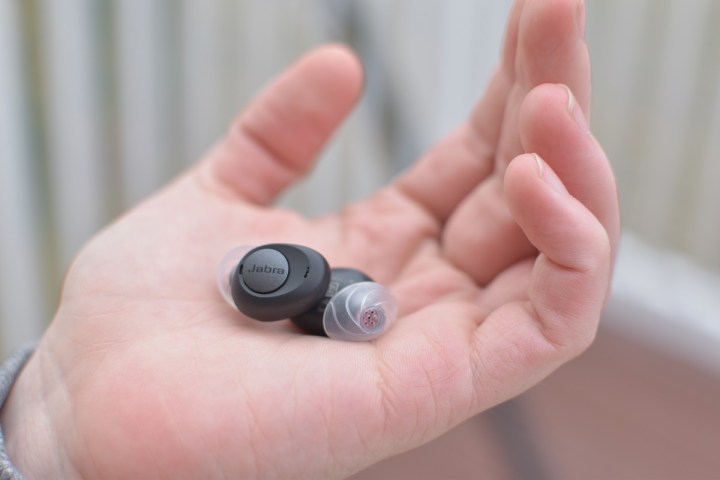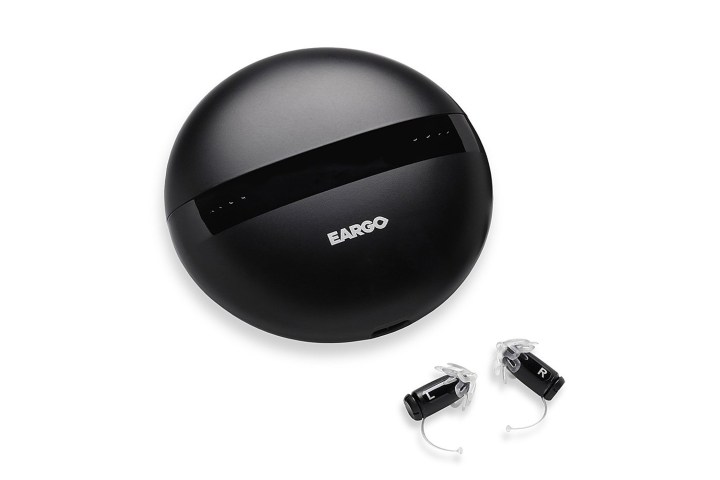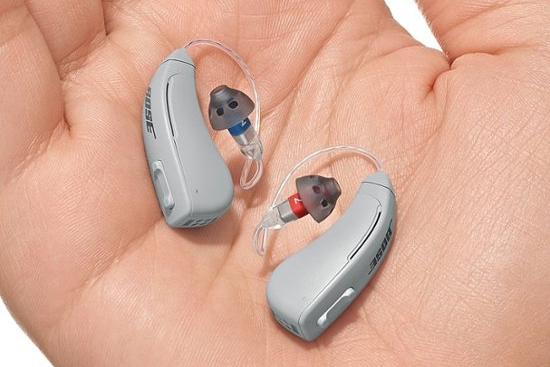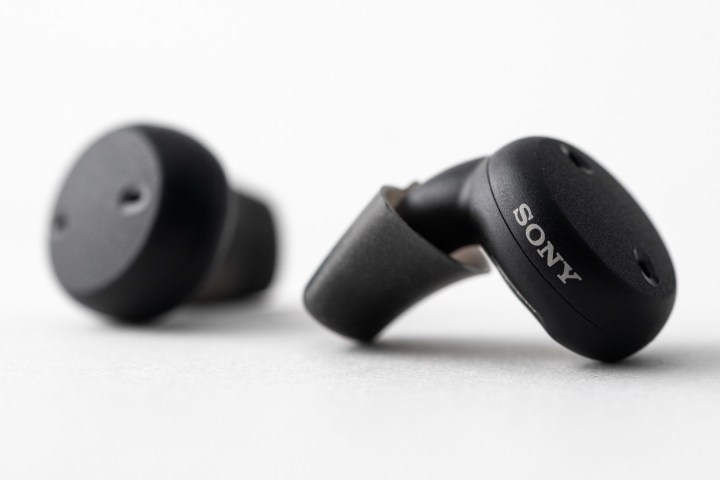If you suffer from mild-to-moderate hearing loss, you may already be aware of the wide world of over-the-counter (OTC) hearing aids that has been growing steadily since the FDA opened up the category in 2022. This allowed hearing loss sufferers to buy hearing aids at brick-and-mortar and online retailers, rather than going through the process of first meeting with a specialist.
These new OTC hearing aids are less expensive than traditional hearing aids, come in a wider variety of design options, and are certified to help with mild to moderate (and sometimes beyond) hearing loss. But as more players get in on the new market, deciding which hearing aid to buy is becoming increasingly difficult.
Let’s take a look at some of the best OTC hearing aids you can buy right now, and why they’re worth picking. We also include our favorite selections for hybrid models (which let you listen to music, too), high-end versions, and more.







Best OTC hearing aids for most people
Jabra Enhance Plus
- Very small size
- Comfortable
- Rechargeable
- Good battery life
- Clear audio quality
- Bluetooth-enabled
- Only work with select iPhones
- Can cause the occlusion effect
- Won't last all day
- Only available through audiologists
One of the biggest benefits of OTC hearing aids – aside from the lower cost – is that you can find a variety of extra features and new design options that can give hearing aids more uses and a better appearance. That is especially true of Jabra’s Enhance Plus hearing aids. These sleek earbuds can easily be mistaken for a pair of Jabra’s traditional Bluetooth buds, and for good reason. They have not only hearing enhancement capabilities, but the ability to play music via Bluetooth and take calls – something not all OTC hearing aids embrace.
In addition to the minimal, multipurpose design, Jabra uses four dedicated microphones designed for medical-grade hearing enhancement to cut down on background noise and boost speech to make it easier to hear what people are saying in noisy environments. They’re also water-resistant, so you don’t have to worry about taking them outside or on workouts. Settings can all be easily controlled via the Jabra Enhance app to personalize and program the buds, then adjusted as needed. Plus, while they’re expensive compared to a normal set of earbuds, they’re on the more affordable side for OTC hearing aids. In the end, putting them at the top of the list wasn’t a hard decision.


Higher-end OTC hearing aids, but worth it
Eargo 5
- Excellent sound and noise processing
- Lifetime telecare support
- Discrete, hidden design
- Good battery life for the size
- Expensive
The least expensive of Eargo's three OTC hearing aid offerings at $1,650 (the Eargo 6 and 7 run $2,250 and $2,950), the three tiers look practically identical with the only differences between them being the internal tech — with noise reduction, filtering, and audio processing getting better up the model chain.
Eargo's form factor is earbud-like, fitting snugly in the ear canal so they won't get in the way of your glasses. The "open fit" design uses a range of soft eartips that include their unique flower petal design that vary in size and seal level, ensuring that you can get a fit that doesn't feel like your ears are plugged.
Eargo's Sound Match system lets you use its app to bypass the hearing clinic and instead use it to carry out a personalized hearing screening. If that's not working for you or you have more specific needs, Eargo has great support, connecting you to licensed hearing professionals over the phone or through the app to help you fine tune the hearing aids.
Eargo’s hearing enhancement technology is superb, with high-quality audio, background noise reduction, and customization over key features such as audio feedback to keep things clear but not overwhelming. The app lets you adjust your hearing preferences, adjust the noise reduction, and choose settings matched tou wherever you are, or what you're doing, such as Restaurant, watching TV, or taking a meeting. You can easily switch between the setting with a tap of your tragus (the part of your ear in front of your concha).
The charging case is much like those of most of today's earbuds, with magnetic pins grabbing onto and holding the hearing aids in place in the case. A full charge to the buds takes just 2.5 hours with the case taking a bit longer at four hours. The earbuds deliver an impressive 16 hours of use, with the charging case getting up to 48 hours total.
The downside is that these are pricey hearing aids compared to many OTC options. They also don’t have a lot in the way of extra features like music playback.


Battery life for days, literally
Sony CRE-C10
- Excellent battery life at 70 hours
- Comfortable earbud design
- Environmental optimization
- No music capabilities
Sony also has its own FDA-registered hearing aids, and their sleek design also invokes more classic earbuds while still providing excellent sound enhancement. That’s partly thanks to the partnership with WS Audiology, which helped supply the technology used in setup, personalization, and automatic optimization based on your surroundings. Their small size isn’t quite as invisible as some picks like the Eargo Neo, but they still do a good job of staying out of sight – and have ear tips in four different sizes for a comfortable fit.
The battery is a particular highlight here, lasting for up to 70 hours on a full charge, a pretty incredible feat for hearing aids this small. It’s a bit disappointing that Sony, which makes some of the best earbuds we’ve ever listened to, didn’t include music compatibility with these hearing aids — for that, you'll have to wait for the CRE-C10's slightly more expensive sibling, the CRE-E10, to arrive — but they’re still a very impressive option.


Traditional design, with premium Bose sound
Lexie B2 OTC Hearing Aids — Powered by Bose
- Bose partnership for many hearing modes
- Ability to save sound profiles
- 18-hour battery life
- 45-day trial period
- Traditional design is a bit clunky
Lexie offers a more traditional hearing aid design, with a primary module that fits behind the ear and is connected to a wired earbud that fits inside the ear. The advantage of this design is that it offers more power and more room for hearing technology, but it can often be more noticeable as a result.
Lexie partnered with Bose for these hearing OTC aids, and the result is a particularly versatile pair of earbuds with a variety of hearing modes for different situations. That includes a World Volume mode for general sound amplification, the ability to adjust treble and bass depending on specific hearing weaknesses, and options to adjust where the sound amplification is focused, like directly in front of you for conversations. You can save your preferred settings under different situations and switch as needed.
The 18-hour battery life is also nice for those who may need to wear hearing aids for most of the day. Plus, you can call Lexie support and get expert troubleshooting to solve problems. We also like that there’s a 45-day trial period during which you can send the earbuds back for free, something not everyone offers with OTC models.


Hybrid design with great ANC
HP Hearing Pro
- Excellent music and hearing features together
- Water resistance
- 15-minute tuning program for each ear
- ANC
- Lower battery life
HP brings an amazing hybrid option to the table for those who want the advantages of both earbuds and hearing aids, plus some unique hearing features that could be very useful for certain users, powered by specialist Nuheara. That includes Ear ID software that tests hearing frequency thresholds for each ear, then programs sound enhancement based on the results: It’s designed to only take around 15 minutes, and you don’t have to worry about making tiny adjustments yourself. It’s supposed to be a quick 30% boost in speech understanding, according to the National Acoustic Libraries.
There’s also full-fledged ANC (active noise cancellation) here to improve overall audio quality, as well as the ability to listen to music and calls via the Bluetooth connection. Plus, there’s a focus mode to direct the sound enhancement toward the front for more difficult-to-hear conversations. Battery life isn’t that great at up to eight hours on a single charge, but with a hybrid model that can do so much and offers thorough tuning, it’s far from an issue — and much aided by the 32-hour charging case.


Another great hybrid, with Sony's cache
Sony CRE-E10
- Excellent sound
- Very configurable with app
- Solid battery life
- Streaming is only for iOS devices
Sony's earbuds are legendary, so it's a bit of a no-brainer that they'd partner with a reputable hearing aid maker like WS Audiology to bring the best of both worlds to the OTC hearing aid space. This sibling to the more hearing aid-style CRE-C10 above, the E10s offer a more familiar earbud design that might be more palatable to those just starting with hearing aids. The other attractive factor to consider is that the E10s have Bluetooth connectivity so you can pair it with your device. Sadly for Android users, they're only compatible with iOS devices though.
Sony also brings its experience with easy setup and in-app hearing customization to the E10, not to mention its excellent sound quality, which is FDA-cleared and prescription grade. Additionally, when wearing the E10 OTC hearing aids, the buds are constantly listening and analyzing the sound around you so they can automatically optimize the hearing aids for the best possible sound, much like many of the best noise-canceling earbuds on the market.
And while they don't boast the same 70-hour battery life as the C10s, the E10s are no slouch either, with up to 26 hours of use on a single charge when using them as hearing aids, or 23 hours when you include two hours of streaming, which means that for every two hours of streaming you do, you'll lose one hour of battery life, which still isn't too bad.

Frequently Asked Questions
If you suspect that you have mild to moderate hearing loss, and are 18 years old or older, then over-the-counter hearing aids might be for you. You don't need to see a doctor or audiologist to determine whether you need them or not, which is part of the benefit of the FDA opening this segment up to consumers. However, for children and those with more severe hearing loss or hearing issues, you should seek a medical professional.
Prescription hearing aids are those that are labelled this way by the FDA. They require a prescription and are usually purchased through an audiologist. They also have a higher volume output than OTC hearing aids and often include features that OTC hearing aids do not. OTC hearing aids, on the other hand, do not require a prescription or a hearing exam, are generally cheaper, and a more readily available from retailers and online.
You can get a pair of OTC hearing aids from places like Walmart, Walgreens, Amazon, Best Buy, and CVS, and they range in price from as low as $200 to upwards of around $1,500.
To buy OTC hearing aids, you do not need hearing test or a prescription, but it's recommended to see a licensed certified audiologist if you're having trouble determining if your hearing loss is in fact mild to moderate -- many people have difficulty determining that for themselves. Who knows, you might need prescription hearing aids instead.
While we have a much broader explainer on how to buy OTC hearing aids, here are a few main tings to keep in mind. You don't need us to tell you to be cost conscious, but it's up to you to determine if you need bells and whistles like Bluetooth music streaming and ANC for your OTC hearing aids. You should also be sure that the model you choose is durable (is water resistance important to you?), easy to clean and repair if need be, and if you can return them after a trial period if they're not right for you.
Additionally, how easy are they to operate? Do you need an app to use them? What extra features and control does the app offer? You'll also want to make sure that the device and/or app is compatible with your smartphone (iOS or Android or both). Lastly, what is the company's support like? Jabra and Eargo, for example, offer excellent product support should you have any issues.




